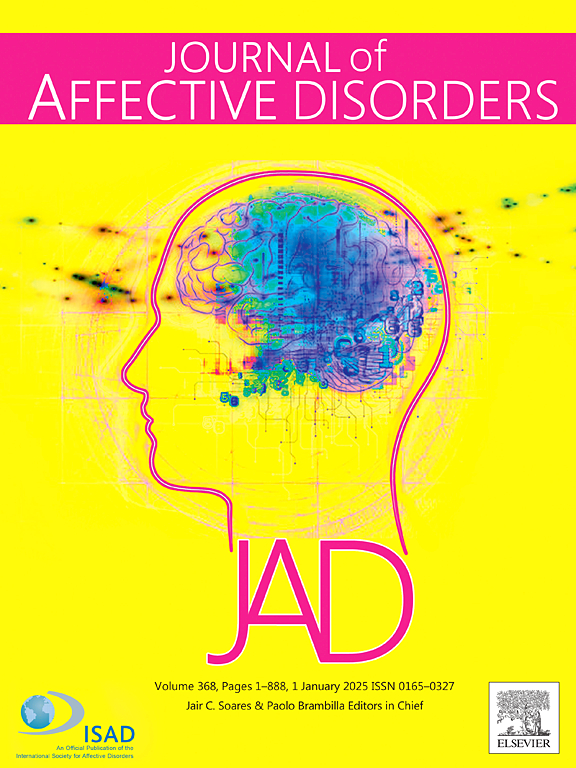The role of emotion dysregulation and rumination in predicting premenstrual symptom severity in premenstrual disorders and elevated anxiety or depression
IF 4.9
2区 医学
Q1 CLINICAL NEUROLOGY
引用次数: 0
Abstract
Premenstrual Dysphoric Disorder (PMDD) and Premenstrual Syndrome (PMS) are prevalent and cause significant distress, yet their psychological mechanisms remain poorly understood. Previous research has linked emotion dysregulation with premenstrual symptoms, but it has often relied on retrospective self-reports, which are prone to bias, and rarely compared PMDD with the milder PMS. Additionally, past studies have not differentiated the heightened emotion dysregulation seen in PMDD from that typically observed in other affective conditions. To address these gaps, we examined the association between emotion dysregulation and premenstrual symptoms in a sample of menstruating individuals meeting criteria for provisional PMDD (N = 39), PMS (N = 160), elevated depression or anxiety (DEPANX; N = 88), and controls (N = 172). All participants completed questionnaires on premenstrual symptom severity and trait global emotion dysregulation, rumination, reappraisal, and suppression. A subset of participants completed a sad mood induction task (PMDD/PMS combined: N = 104; DEPANX: N = 54; Control: N = 161) and reported in vivo use of emotion regulation strategies. Compared to controls, all groups reported greater in vivo and trait rumination, higher trait emotion dysregulation, and lower trait reappraisal. The PMDD group endorsed greater rumination and emotion dysregulation than both the PMS and DEPANX groups. Greater trait emotion dysregulation and rumination predicted higher premenstrual symptom severity across groups. Rumination was the strongest predictor of premenstrual symptom severity between groups, compared to other emotion dysregulation measures. These findings raise the possibility that emotion dysregulation, particularly rumination, plays a role in the aetiology and/or maintenance of impairing premenstrual symptoms, although longitudinal research is needed to further explore these relationships.
情绪失调和反刍在预测经前症状严重程度、经前障碍和焦虑或抑郁升高中的作用。
经前烦躁不安症(PMDD)和经前综合症(PMS)普遍存在并引起严重的痛苦,但其心理机制仍知之甚少。先前的研究已经将情绪失调与经前症状联系起来,但它往往依赖于回顾性的自我报告,这容易产生偏见,而且很少将经前不悦症与较轻的经前综合症进行比较。此外,过去的研究并没有将经前不悦症中观察到的高度情绪失调与其他情感状况中典型观察到的情绪失调区分开来。为了解决这些差距,我们检查了符合临时经前不悦症( = 39)、经前综合症( = 160)、抑郁或焦虑升高(DEPANX;N = 88),对照组(N = 172)。所有参与者完成经前症状严重程度和特质整体情绪失调、反刍、重新评估和抑制问卷。一部分参与者完成了悲伤情绪诱导任务(PMDD/PMS联合:N = 104;DEPANX: N = 54;对照组:N = 161),并报道了在体内使用情绪调节策略。与对照组相比,所有组都报告了更多的体内反刍和特质反刍,更高的特质情绪失调和更低的特质重新评估。经前抑郁组比经前综合症组和DEPANX组都有更多的反刍和情绪失调。更大的特质情绪失调和反刍预示着各组间更严重的经前症状。与其他情绪失调指标相比,反刍是两组间经前症状严重程度的最强预测因子。这些发现提高了情绪失调的可能性,特别是反刍,在经前症状的病因学和/或维持中起作用,尽管需要纵向研究来进一步探索这些关系。
本文章由计算机程序翻译,如有差异,请以英文原文为准。
求助全文
约1分钟内获得全文
求助全文
来源期刊

Journal of affective disorders
医学-精神病学
CiteScore
10.90
自引率
6.10%
发文量
1319
审稿时长
9.3 weeks
期刊介绍:
The Journal of Affective Disorders publishes papers concerned with affective disorders in the widest sense: depression, mania, mood spectrum, emotions and personality, anxiety and stress. It is interdisciplinary and aims to bring together different approaches for a diverse readership. Top quality papers will be accepted dealing with any aspect of affective disorders, including neuroimaging, cognitive neurosciences, genetics, molecular biology, experimental and clinical neurosciences, pharmacology, neuroimmunoendocrinology, intervention and treatment trials.
 求助内容:
求助内容: 应助结果提醒方式:
应助结果提醒方式:


